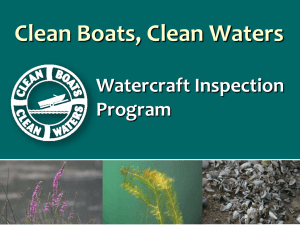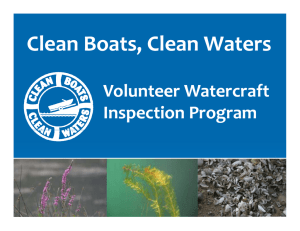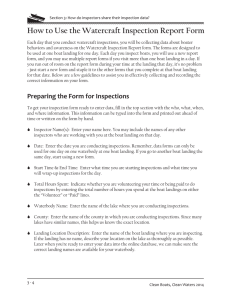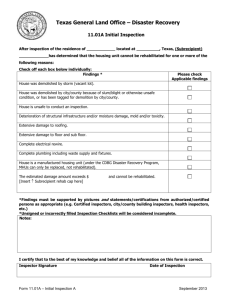Section 3: How do inspectors share their inspection data?
advertisement
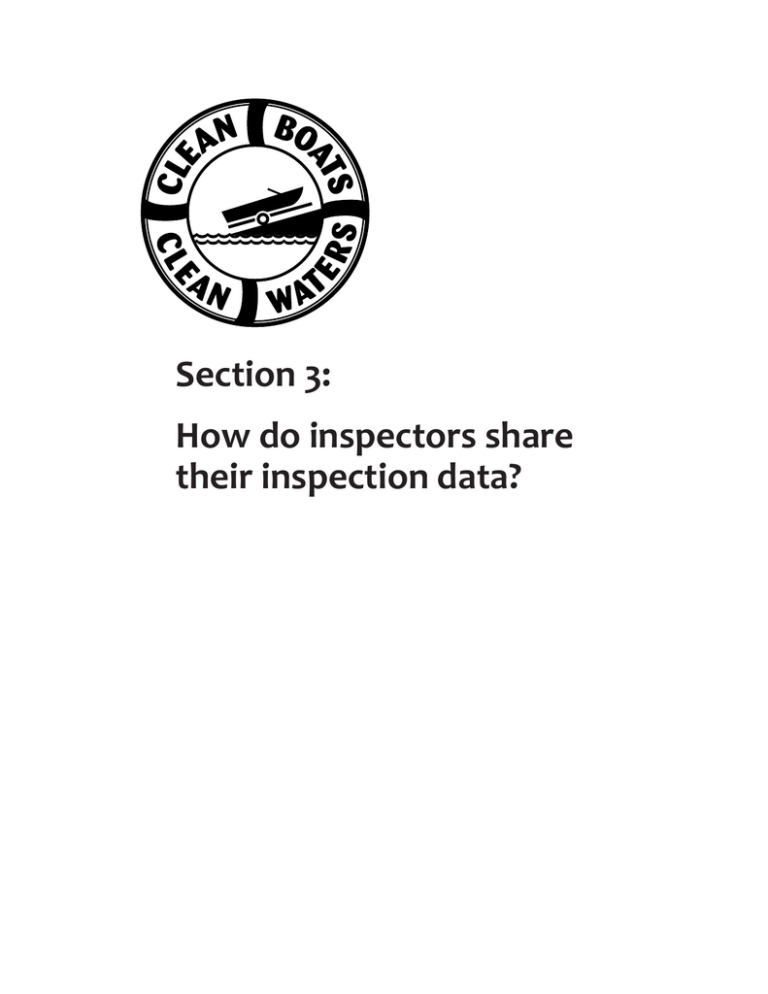
Section 3: How do inspectors share their inspection data? Section 3: How do inspectors share their inspection data? Collecting & Reporting Inspection Data As a part of conducting watercraft inspections, data is collected by volunteer and paid Clean Boats, Clean Waters inspectors at boat landings and recorded on the Watercraft Inspection Report form. This form contains questions that help citizens and the state better understand boaters’ knowledge and behaviors regarding aquatic invasive species. The data gathered at the boat landings is then entered into a large online database, called the Surface Water Integrated Monitoring System or SWIMS, by watercraft inspectors. There are many advantages to keeping records for the watercraft inspection program: •• With limited state resources, it makes sense for each inspection team to track their own data. •• Collecting data helps the inspection team discover traveling patterns of boaters who visit their lake. •• The data may be useful information if the local lake association or lake district applies for a DNR Lake Planning and Management Grant or an Aquatic Invasive Species Prevention and Control Grant. •• The data could also be useful for local ordinance reviews that pertain to the boat landing or waterbody use. Data collected at boat landings provides citizens and the state with valuable information. Photo by Robert Korth Watercraft Inspector Handbook •• Most importantly, by recording and sharing information on SWIMS online database, inspection teams will assist lake managers with invasive species prevention and control and will quantify the impacts that both paid and volunteer inspectors are having on invasive species. Having this information helps justify the continued need to support the invasive species programs. 3-3 Section 3: How do inspectors share their inspection data? How to Use the Watercraft Inspection Report Form Each day that you conduct watercraft inspections, you will be collecting data about boater behaviors and awareness on the Watercraft Inspection Report form. The forms are designed to be used at one boat landing for one day. Each day you inspect boats, you will use a new report form, and you may use multiple report forms if you visit more than one boat landing in a day. If you run out of room on the report form during your time at the landing that day, it’s no problem - just start a new form and staple it to the other forms that you complete at that boat landing for that date. Below are a few guidelines to assist you in effectively collecting and recording the correct information on your form. Preparing the Form for Inspections To get your inspection form ready to enter data, fill in the top section with the who, what, when, and where information. This information can be typed into the form and printed out ahead of time or written on the form by hand. 66 Inspector Name(s): Enter your name here. You may include the names of any other inspectors who are working with you at the boat landing on that day. 66 Date: Enter the date you are conducting inspections. Remember, data forms can only be used for one day on one waterbody at one boat landing. If you go to another boat landing the same day, start using a new form. 66 Start Time & End Time: Enter what time you are starting inspections and what time you will wrap-up inspections for the day. 66 Total Hours Spent: Indicate whether you are volunteering your time or being paid to do inspections by entering the total number of hours you spend at the boat landings on either the “Volunteer” or “Paid” lines. 66 Waterbody Name: Enter the name of the lake where you are conducting inspections. 66 County: Enter the name of the county in which you are conducting inspections. Since many lakes have similar names, this helps us know the exact location. 66 Landing Location Description: Enter the name of the boat landing where you are inspecting. If the landing has no name, describe your location on the lake as thoroughly as possible. Later when you’re ready to enter your data into the online database, we can make sure the correct landing names are available for your waterbody. 3-4 Clean Boats, Clean Waters 2014 Section 3: How do inspectors share their inspection data? Collecting Data During Inspections Now you’re ready to begin inspections. When you encounter a boater, you will introduce yourself and begin your conversation with them about AIS. The questions to ask them are outlined on the form as follows, and you will record their responses, in most cases by marking the appropriate boxes on the data form. 66 In the “Boat Was...” section, note if the boat or trailer was entering the water or leaving the water. On waters that have aquatic invasive species already present, inspections should take place as boaters and anglers are leaving the landing. Sharing information with them as they leave the water helps ensure the AIS are being contained in that waterbody and not being spread elsewhere. On waters free of AIS, inspectors have a choice of educating boaters when they’re entering or leaving the water. Either time offers a good opportunity to share information. 66 The “Questions to Ask Boater” section includes three questions that you should talk about with the boater. ••Have you been contacted by an inspector this season? Answers to this question help prevent you from sharing the same AIS prevention message with the same boaters over and over. We don’t want to over-saturate the same boaters with the same message - this could frustrate them. This question also helps us to learn more about how many boaters and anglers we are reaching with inspections. It also tells you about the boater’s potential awareness of AIS and boat inspections. Boaters who have never talked to an inspector before will often need more information than someone who has been inspected previously. ••Are you willing to answer a few questions? If the answer is yes, continue on to the next question. If the answer is no, thank the boater for their time and tell them to have a nice day. Your conversation with them is complete. ••Was the boat used during the past five days on a different waterbody? If the answer if yes, record the name (and county and state, if possible) of the last waterbody. This allows state and local groups to compile information on boater traveling patterns. If the answer is no or I don’t know, please indicate that my marking the corresponding box. 66 You’re now ready to engage the boater in an educational conversation, using the questions and prompts listed under the “Discuss Following Prevention Steps with Boater” section. ••Following the steps listed on the form, share the prevention message step by step and ask the follow-up questions listed after each step with the boater. Use the prompts provided on the “AIS Prevention Steps Prompts” handout to assist you with localizing your message and answering any questions you receive. Watercraft Inspector Handbook 3-5 Section 3: How do inspectors share their inspection data? ••For all anglers, share the additional step and follow-up question regarding draining livewells. If the angler uses live bait, please share the bait message and follow-up question included on the form. This information can also be shared with boaters who have questions about bait laws. 66 The last two questions on the form are observations and opinions to be recorded by the inspector. These are not questions that should be asked of the boater. ••The “Number of People Contacted” question refers to the number of people who heard your message. This can include any children who were listening while their parents prepared to launch their boats or individuals who were simply visiting the landing. ••The “I feel confident that boater understands the steps necessary to prevent the spread of AIS” question asks for your opinion. After talking with the boater about the prevention steps, indicate your level of confidence that the boater understands the prevention steps. This is not the same as whether of not you feel the boater will take the steps - just how confident you are that they received the AIS message. Wrapping Up After Inspections Once you’ve completed your inspections at that boat landing for the day, you may have one form or many forms full of the data that you’ve collected. Before you put the forms aside to enter later, be sure to do just a few quick things to make sure your data form is complete. 66 Fill in any additional thoughts or comments you’d like to record in the “Comments” section at the bottom of the form, such as the weather conditions, if there were any unusual occurrences that day, or anything else you’d like to share. 66 Data is collected and entered for each landing each day. If you have multiple data sheets, use the “Sheet___of___” spot to indicate how many total sheets you have for that day and number each sheet accordingly. 66 Lastly, total each column on the datasheet and enter the total number in the last row titled “Totals”. To do this, count the number of checks or marks you have made in each column and record that number in the “Totals” row (the exception being the waterbody and county/ state names as they cannot be totaled). Don’t forget, data is collected and entered for each landing each day. So, if you have multiple datasheets, you’ll count the column marks on all of the datasheets and have a grand total for each column that includes the data from all sheets. Now you’re ready to enter your data into the online database known as SWIMS (Surface Water Integrated Monitoring System). More information and instructions on how to enter data can be found in the following pages. Best of luck in your watercraft inspection program, and remember to let boaters know that they’re making a difference by following the prevention steps! 3-6 Clean Boats, Clean Waters 2014 Section 3: How do inspectors share their inspection data? Watercraft Inspector Handbook 3-7 Section 3: How do inspectors share their inspection data? Sharing Information Everyone who attends a “Clean Boats, Clean Waters” training workshop is entered into the watercraft inspector database. Each participant’s name, address, and contact information is collected during the workshop and reported in the inspector database. This helps us keep track of the inspection efforts that are going on around the state. Obtain a SWIMS User ID & Password Ready to enter your inspection data? Watercraft inspectors must obtain a user ID and password before they can enter any information into the SWIMS online database. Here’s how: 1. Go to: https://on.wisconsin.gov. 2. Click on the link labeled “Self-Registration”. 3. Scroll all the way down to the bottom of the page and click “Accept”. 4. Fill in your name and e-mail address. (Note: Only fields with a red asterik* next to them need to be filled out. Leave the postal address field blank. Addresses for inspectors are kept in a separate database.) 5. Choose a User ID, password, and a secret question (used in case you forget your account information.) 6. Click “Submit”. Now check your e-mail account. You should have an e-mail from “wisconsin.gov”. Open the e-mail and click on the link in the e-mail. Log in with your new User ID and password. 7. You’re almost done! The final step is to e-mail your User ID to: jennifer.filbert@wisconsin.gov. In the e-mail, state that you are a part of Clean Boats, Clean Waters and say where you are going to be inspecting (i.e. Big Lake in Shawano County). Also, mention if your inspection efforts are part of a DNR lake or AIS grant. Within a couple of business days, your User ID will be entered into the SWIMS database, and you will be sent an e-mail letting you know that you’re all set up to enter data. Common Questions/Issues & Tips: ÖÖ When I open the e-mail to click the link, the link doesn’t work. If the link in the e-mail wraps to the second line and if you click and don’t get a log in page, try copying and pasting the part that wrapped around onto the end of the URL. ÖÖ I don’t know what to put for the Secret Question. The secret question should be something you can easily remember that doesn’t change. You want to pick something where there aren’t too many ways to type the answer. For example, name of first pet, color of first car you owned. The secret question has nothing to do with your password, but if you forget your password, it’s a way for the computer to tell that it’s really you. ÖÖ I don’t have an e-mail address. If you don’t have an email address, there are many places on the Web where you can get a free email account from Google, Hotmail (MSN), Yahoo!, etc. 3-8 Clean Boats, Clean Waters 2014 Section 3: How do inspectors share their inspection data? ÖÖ When I try to fill in my information (name, address, etc.), it doesn’t accept it. There is a bug with entering postal addresses, so leave the address blank. Also note: even if you don’t fill in the address, addresses for inspectors are kept in a separate database system, so we will still have your address if you have already given it to us. ÖÖ I got a user id and password, but when I try to log into SWIMS, but it won’t recognize me. Be sure to e-mail your user ID to Jennifer (see step 8). Entering Your Data Into SWIMS After you receive your user ID and password, you will be able to enter the information you have collected during the watercraft inspections. Online data entry involves entering the numbers in the“Totals” row located at the bottom of your report form. Here are step-by-step instructions on how to enter your inspection data into SWIMS: 1. Go to: http://dnr.wi.gov/lakes/cbcw-data (this web address is also listed on the Watercraft Inspection Report form). 2. Log in with your user ID and password. If you forget your password, just click on “Forgot Your Password?” 3. Your “My Projects” page will list your active CBCW projects. Projects are often specific to the lake being inspected (example: Clean Boats, Clean Waters - Long Lake). If you are inspecting many waterbodies in a county, your project may be broken down by county and year (example: Clean Boats, Clean Waters - Oneida County). Click “Enter Data”. 4. Ensure the correct project is listed by using the dropdown menu. Then, select the data collectors and station (boat landing). If there are additional data collectors that you’d like to add but they’re not listed in the dropdown menu, send jennifer.filbert@wisconsin.gov a list of names, and she will add them to you dropdown box. Alternatively, inspector names can be listed in the “Comments” field. Watercraft Inspector Handbook 3-9 Section 3: How do inspectors share their inspection data? 5. Select the Start date and time (when you started working at the landing that day). End date and time are optional. 6. Under Form, ensure the Watercraft Inspection Report (Revised 3/2014) is selected. 7. Down below, you have the option of entering the End Date and Time, as well as your written observations in the comments box (i.e. weather, wildlife). 8. Click “Next” to begin filling in your totals. The data you enter will be in the “Totals” row found at the bottom of your report form. 9. When you’ve filled in the totals, click “Next” and you can enter any waterbody names that boaters reportedly visited during the past five days. 10. Then, click “Next Date” to continue entering data for another day, or click “Next Station” to enter data collected at another boat landing. If you’re finished with data entry, click “Done”. When you click “Done”, you will see the data you recently entered. Editing Existing Data You can edit data you’ve entered during the current inspection season. Here’s how: 1. Log into SWIMS at: http://dnr.wi.gov/lakes/cbcw-data. 2. Click “Edit Data” listed under your CBCW project. Click the pencil icon for the date you want to edit. 3. You can edit comments, etc. on the first page if necessary, and then click “Next”. You can now edit your results. If you hit “Save and Return to List”, your changes will save, and you’ll return to the list of data entries. 3 - 10 Clean Boats, Clean Waters 2014 Section 3: How do inspectors share their inspection data? Common Question: ÖÖ What if the landing I need isn’t listed? What if I’m not sure? You can select a landing and click “Show Map” to see where it is located. Otherwise, contact Jennifer at jennifer.filbert@wisconsin.gov to have a landing added or to suggest a better description for the landing. If you need assistance with anything related to reporting your data, feel free to contact Jennifer at jennifer.filbert@wisconsin.gov. Project Details After logging into SWIMS, you will see your “My Projects” page that lists all of the projects you are associated with. By clicking “More” under a specific project, you can view the details of that project. You can also access a variety of project details and resources located in the tool bar on the right-hand side of the page. This includes information like: a list of the landings associated with the project, a list of inspectors involved in the project, data download and summary graphs of the project data, and links to the CBCW manual, Watercraft Inspection Report form, and more. Watercraft Inspector Handbook 3 - 11 “Anything else you’re interested in is not going to happen if you can’t breathe the air and drink the water. Don’t sit this one out. Do something. You are by accident of fate alive at an absolutely critical moment in the history of our planet.” - Carl Sagan

